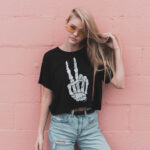Introduction to the Evolution of Fashion
Fashion is more than just fabric and trends; it’s a reflection of society’s evolution. Each decade tells a unique story, revealing the cultural shifts that have shaped our world. From the flapper dresses of the roaring twenties to the rebellious styles of youth in the sixties, fashion has continuously adapted to mirror societal changes.
As we delve into each era, we’ll explore how historical events, music, and art influenced what people wore. The vibrant colors and daring designs not only showcase creativity but also serve as a timeline for understanding social movements and attitudes.
Join us on this fascinating journey through time as we uncover the distinct characteristics that defined fashion in each decade. Let’s step behind the scenes of style history!
1920s: The Roaring Twenties and the Rise of Flapper Fashion
The 1920s marked a vibrant shift in fashion, characterized by rebellion and liberation. Women began to embrace a new sense of freedom, breaking away from the constraints of previous decades.
Flapper fashion emerged as a bold statement. Shorter hemlines, dropped waistlines, and loose-fitting silhouettes allowed for more movement on the dance floor. The iconic bob haircut became synonymous with this daring lifestyle.
Accessories played an essential role too. Long strands of pearls and feathered headbands adorned flappers, adding an air of glamor to their outfits. This was also the era when jazz music thrived—its lively rhythms inspiring women to express themselves through style.
The influence of art deco design seeped into clothing patterns and colors, making everything feel fresh and modern. It was truly a decade where individuality flourished through fashion choices that were both playful and sophisticated.
1930s: The Influence of Hollywood Glamour on Fashion
The 1930s marked a golden era where Hollywood glamour took center stage in the fashion world. Movie stars became style icons, influencing women everywhere to embrace elegance and sophistication.
Silhouettes transformed during this decade. The introduction of bias-cut fabrics allowed dresses to hug the body’s curves gracefully. Designers like Elsa Schiaparelli created stunning pieces that combined art with apparel, captivating audiences both on-screen and off.
The allure of films brought dramatic styles into everyday life. Evening gowns sparkled with sequins, while tailored suits for men exuded sharp sophistication. Everyone wanted a taste of that cinematic charm.
Accessories played an essential role too—think wide-brimmed hats and statement jewelry elevating simple outfits into show-stoppers. This was not just about clothing; it was about embodying the confidence seen in beloved film stars like Jean Harlow and Bette Davis.
Fashion evolved from mere practicality to a means of self-expression, fueled by the glitz and glamor radiating from Hollywood’s silver screen.
1940s: The Impact of World War II on Fashion Trends
The 1940s were marked by a world at war, and fashion was deeply influenced by the tumultuous times. Utility became the keyword as countries faced shortages of materials. Designers had to adapt creatively, crafting garments that balanced style with practicality.
Women stepped into roles traditionally held by men, leading to a shift in dress styles. The iconic ‘Rosie the Riveter’ image symbolized strength and resilience. Workwear emerged, featuring tailored trousers and sturdy fabrics designed for functionality.
Evening wear took on a more glamorous tone despite fabric rationing. Dresses featured bold silhouettes with structured shoulders and cinched waists—feminine yet assertive.
Accessories also evolved during this decade. Hats became statement pieces while jewelry morphed into designs using less precious material but still exuding elegance. Fashion served not only as self-expression but also as a reflection of societal changes amid adversity.
1950s: The Golden Age of Couture and the Birth of Teenage Fashion
The 1950s marked a pivotal moment in fashion history. It was the era where couture thrived, bringing forth iconic designers like Christian Dior and his revolutionary “New Look.” This silhouette emphasized femininity with its cinched waists and voluminous skirts.
As haute couture dazzled on runways, something new emerged from the streets. Teenage fashion began to take shape, driven by youth culture’s desire for identity and expression. The rise of rock ‘n’ roll influenced styles that were bold and rebellious.
Teenagers embraced denim jeans, leather jackets, and graphic tees as symbols of freedom. Icons like James Dean epitomized this shift with their effortlessly cool looks.
This decade witnessed a fascinating blend—glamour met youthful exuberance, making it unforgettable in the realm of style. Fashion became not just about clothing but about telling stories through garments that resonated with both young rebels and elegant socialites alike.
1960s: The Swinging Sixties and the Revolution of Youth Culture in
The 1960s marked a seismic shift in the fashion landscape. This decade was characterized by an explosion of creativity and self-expression, driven largely by the rise of youth culture. The post-war generation sought to break free from traditional norms, embracing new ideas and styles that reflected their desire for freedom.
Fashion became a canvas for rebellion. Mini skirts emerged as symbols of liberation, while bold prints and psychedelic colors captured the spirit of experimentation that defined this era. Designers like Mary Quant spearheaded trends that not only changed how people dressed but also influenced societal attitudes toward gender roles.
Music played a pivotal role during this transformative time. Icons like The Beatles and Jimi Hendrix didn’t just change music; they also set trends with their distinctive looks—think tailored suits or flamboyant attire filled with vibrant patterns. Each outfit carried meaning and told stories about identity, making statements beyond mere aesthetics.
As counterculture movements gained momentum, so did alternative fashion choices such as tie-dye shirts, bell-bottom jeans, and vintage thrift finds. These styles celebrated individuality over conformity. Fashion magazines began showcasing diverse models who embodied these ideals rather than adhering to previous standards of beauty.
The impact wasn’t limited to clothing alone; it extended into accessories too—with peace signs becoming emblematic of an entire generation’s ethos against war and injustice.
This whirlwind period reshaped society’s view on what it meant to dress well—it wasn’t just about looking good anymore but expressing one’s beliefs through personal style.
The legacy left behind continues influencing designers today while reminding us how powerful fashion can be in reflecting social change.


